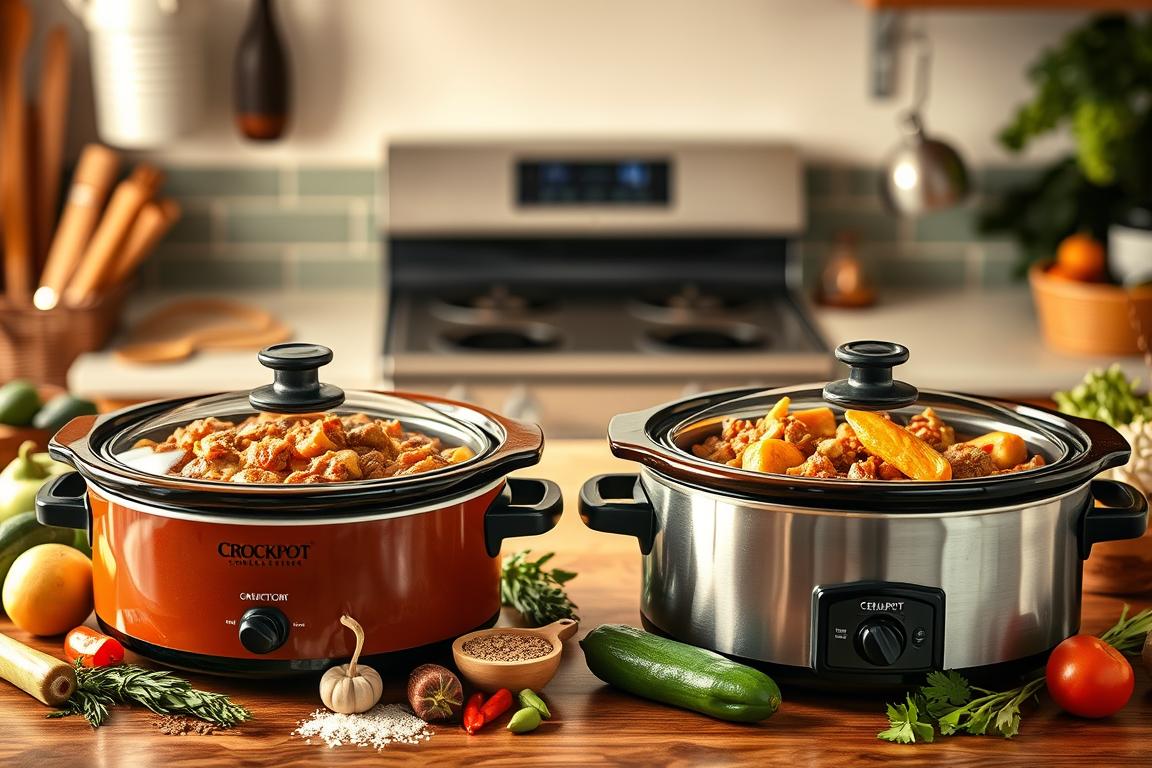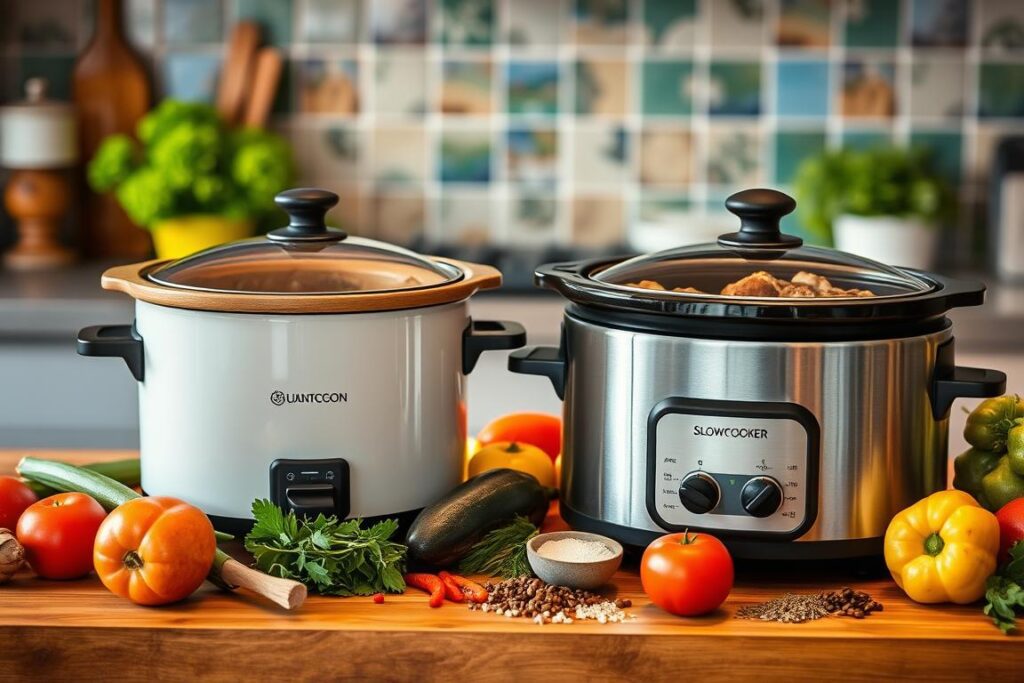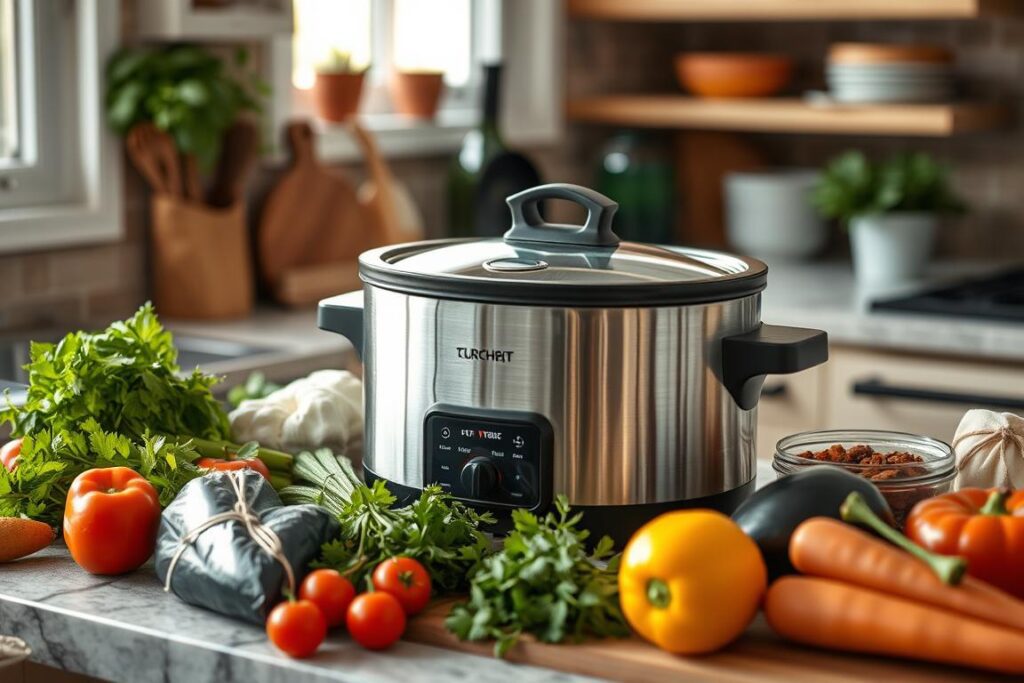Introduction
What’s the difference between a crockpot and a slow cooker? Crockpots and slow cookers are often confused with each other, but they are not the same. Both use moist heat for cooking over a long time. They have a pot, a glass lid, and a heating element. But, a Crockpot is a specific brand that made this cooking method popular.
While all Crockpots are slow cookers, not all slow cookers are Crockpots. This article will look at the main differences between these kitchen tools. We’ll cover their features and cooking methods to help you pick the best one for you.
Key Takeaways
- Crockpots and slow cookers are similar in their cooking mechanisms, but Crockpot is a specific brand that pioneered the slow cooking appliance.
- Slow cookers come in various styles and brands, while Crockpots are a specific type of slow cooker with a distinct ceramic pot and heating element configuration.
- Slow cookers offer a range of temperature settings, while Crockpots typically have two main settings: low and high.
- Slow cookers can be used for a wider variety of recipes, while Crockpots are particularly well-suited for stews, soups, and braised dishes.
- Slow cookers are generally more versatile, allowing for searing, steaming, and other cooking methods, whereas Crockpots are primarily used for long, slow cooking.
Understanding the Origins: From Bean Cooker to Modern Appliance
The crockpot’s history starts in the early 20th century. It became popular in the 1970s. The Crock-Pot brand was first known as a bean cooker.
Over time, it changed. It got handles and a glass lid. Now, it’s the slow cooker we all know.
The Birth of Crock-Pot Brand in 1970
In 1970, the Rival Manufacturing Company launched the Crock-Pot brand. This marked the beginning of crockpot history. By 1975, sales skyrocketed to 3.7 million units.
But, by the 1980s, sales dropped. This was due to more competition from other brands.
Evolution of Slow Cooking Technology
As slow cooker evolution continued, more brands entered the market. This made slow cookers more popular. By the 1980s, 40 companies were making slow cookers.
Market Development and Brand Recognition
The Crock-Pot brand grew in popularity. It changed hands a few times, from the Rival Manufacturing Company to Jarden in 2005. Today, Crock-Pot is still a top brand.
It’s on “Best Of” lists and is a big name in slow cookers. Even with new brands like Instant Pot, Crock-Pot stays strong.
What’s the difference between a crockpot and a slow cooker?
The terms ‘crockpot’ and ‘slow cooker’ are often mixed up. But, there are some key differences. ‘Crockpot’ is a brand name for a specific type of slow cooker. On the other hand, ‘slow cooker’ is a general term for the appliance.
Crockpot-style slow cookers have a ceramic or porcelain pot inside a heating unit. The heat comes from the bottom and sides, making for even cooking. Other slow cookers might have a metal pot on top of a heating unit, with heat mainly at the bottom.
Another difference is in the heat settings. Crockpots usually have just ‘Low’ and ‘High’ settings. But, other slow cookers offer more temperature options. The ‘Low’ setting is best for cooking food slowly over hours, bringing out the flavors.
| Feature | Crockpot | Slow Cooker |
|---|---|---|
| Pot Material | Ceramic or Porcelain | Metal |
| Heat Distribution | Bottom and Sides | Bottom |
| Heat Settings | Low and High | Varied Temperatures |
Choosing between a Crockpot and a generic slow cooker depends on your needs. Both are great for making delicious, easy meals. Knowing the differences helps you get the best results from your slow-cooked dishes.
Design and Construction Features
Slow cookers rely on their design and build to work well. The placement of heating elements, the materials used, and the pot shapes all matter. These details can greatly affect how well you cook.
Heating Element Placement
Slow cookers differ in where their heating elements are placed. Crock-Pot models, for example, have ceramic or porcelain pots. The heating elements are at the bottom and sides. This setup helps distribute heat evenly.
Other slow cookers have metal pots on top of heating elements. This can lead to uneven heating, especially at the bottom.
Material Composition
The materials used in slow cookers also play a part. Ceramic and porcelain pots, like those in Crock-Pot models, distribute heat well. They keep moisture in, making food tender and flavorful.
Metal pots heat up quicker but might not cook food evenly. They can dry out food faster.
Pot Types and Configurations
Crock-Pots usually come in round or oval shapes. They range in size from 2-quart to 7-quart. The oval shape allows for bigger food items and faster cooking.
Some slow cookers have pots that can be taken out. These can be used on the stovetop or in the oven. This adds to their kitchen versatility.
“The design and construction of a slow cooker can make a significant difference in its cooking performance and overall user experience.”
Temperature Settings and Heat Distribution
Crockpots and slow cookers differ in temperature control. Crockpots, known for their iconic design, usually have two settings: LOW (around 200°F) and HIGH (around 300°F). Some models also have a WARM setting for keeping dishes warm.
Other slow cookers offer more temperature options. They can have up to five or more heat settings. This lets users adjust cooking to their liking, whether it’s a stew or a dip.
The heating element’s location affects heat distribution. Crockpots, with their side-mounted elements, cook food evenly. This means you don’t need to stir often. Slow cookers with bottom elements might need more attention to avoid scorching.
| Feature | Crockpot | Slow Cooker |
|---|---|---|
| Heat Settings | Typically 2: Low (200°F) and High (300°F) | Range of 5+ heat settings |
| Heating Element Placement | Sides | Bottom |
| Heat Distribution | Even and consistent | May require more stirring for even cooking |
The differences in temperature and heat distribution matter for your slow-cooked dishes. Knowing these differences helps you choose the right appliance and cooking methods. This ensures your dishes turn out perfectly every time.
Cooking Performance Comparison
Crockpots and slow cookers cook food differently. Crockpots have side heating elements for even heat. This means you don’t need to stir food as much. Slow cookers, with heating elements at the bottom, might cook food slower and need more stirring to cook evenly.
Heat Distribution Patterns
Crockpots cook food more evenly because of their design. The heat surrounds the food, making it cook consistently. Slow cookers can have hot spots, leading to uneven cooking and overcooked food.
Cooking Times and Temperature Ranges
Crockpots have two heat settings: high and low. Slow cookers offer more settings, from 1 to 5, for more control. This lets you adjust cooking times and temperatures to your liking.
Food Safety Considerations
The USDA says slow cookers are best for soups and stews. This helps food cook fast and safely. Both crockpots and slow cookers are safe if used right and follow food safety rules.
| Feature | Crockpot | Slow Cooker |
|---|---|---|
| Heat Distribution | Even, with side heating elements | May have “hot spots” near the bottom |
| Heat Settings | High (around 300°F) and Low (around 200°F) | Varied range, usually numbered 1 through 5 |
| Recommended Dishes | Versatile, can cook a wide range of dishes | Recommended for soups, stews, and dishes with smaller food pieces |
In summary, crockpots and slow cookers cook food in different ways. Crockpots cook evenly, while slow cookers offer more temperature options. Both are safe for cooking, but the USDA suggests using slow cookers for quicker, safer cooking.
Brand vs Generic: Understanding the Terminology
In the world of kitchen appliances, “crockpot” and “slow cooker” are often used the same way. But, they actually mean different things. It’s key to know the difference, especially when talking about this versatile cooking tool.
The Crock-Pot brand was introduced by Rival Manufacturing Company in 1971. Over time, Crock-Pot has become almost a synonym for slow cookers. Many people call any slow cooker a “crockpot,” just like how “Band-Aid” is used for any adhesive bandage.
While Crock-Pot is a big name in slow cookers, other brands also make similar appliances. The term “slow cooker” covers all these, including Crock-Pots. Rival, the Crock-Pot creator, now offers over 15 models. These range in size and function, making up 85% of slow cookers sold.
| Brand | Model | Price |
|---|---|---|
| West Bend | 6-Quart Crockery Cooker | $18.32 |
| Rival | 6-Quart Oval Versaware Slow Cooker | $49.99 |
| Rival | 5-Quart Round Smart-Pot Programmable Slow Cooker | $35.05 |
| All-Clad | 7-Quart Stainless-Steel Slow Cooker | $99.95 |
In short, while “crockpot” and “slow cooker” are often used the same way, Crock-Pot is a specific brand. “Slow cooker” is the broader term for all kitchen appliances made for slow cooking.
Versatility and Usage Applications
Slow cookers and Crock-Pots are amazing for making many dishes. They’re great for soups, stews, pot roasts, and even desserts. These appliances cook food slowly, making tough meat tender and adding deep flavors.
Crock-Pots are especially good because they cook evenly. This is perfect for dishes that need gentle, steady heat.
Best Foods for Each Appliance
Slow cookers and Crock-Pots can make many recipes. But, some dishes are better for each:
- Slow Cookers: Soups, chili, braised meats, oatmeal, risotto, and some desserts like cobblers or bread pudding.
- Crock-Pots: Stews, pot roasts, pulled pork, chicken and dumplings, and even some baked goods like cakes or cheesecakes.
Cooking Techniques and Tips
To get the best from your slow cooker or Crock-Pot, follow these tips:
- Fill the appliance 1/2 to 2/3 full for optimal heat distribution and cooking performance.
- Avoid lifting the lid frequently, as this can significantly extend the cooking time.
- Use recipes specifically designed for slow cooking, as they will provide the right timing and temperature settings.
- Consider investing in a multicooker or Instant Pot, which offers slow cooking as well as other functions like pressure cooking and sautéing.
By using these versatile appliances, you can make tasty slow cooker recipes and crockpot cooking tips. They make cooking easy and convenient. Enjoy the benefits of versatile cooking appliances like slow cookers and Crock-Pots.
Maintenance and Care Requirements
Keeping your Crock-Pot or slow cooker in good shape is key. Always unplug it and let it cool down before you start cleaning or doing maintenance. This helps prevent accidents and damage.
Most ceramic and porcelain pots are safe for the dishwasher. But, always check the manual for specific care tips. For tough stains, soak the pot in warm, soapy water first. This makes cleaning easier. Never let the temperature change too fast, as it can crack the pot.
For the outside, use a damp cloth to wipe it clean. Make sure not to get the heating unit or base wet. Also, check the power cord and plug often for any damage. If you find any, contact the maker for help.
FAQ
What are The easiest crockpot recipes
The easiest crockpot recipes include chili, pulled pork, chicken tacos, pot roast, and mac and cheese. Just combine simple ingredients, set, and enjoy hassle-free cooking!
What’s the difference between a crockpot and a slow cooker?
Crock-Pot is a brand of slow cooker. “Slow cooker” is a term for any appliance that cooks food slowly. Crock-Pots have a ceramic pot inside a heating unit. Other slow cookers might have a metal pot on top of a heating unit.
How did the Crock-Pot brand come about?
The Crock-Pot brand started in 1970 as a bean cooker. It evolved into the versatile slow cooker we know today. The design changed over time, adding handles and a glass lid.
How have slow cookers evolved over time?
Slow cooking technology has grown, leading to more brands and models. This has made slow cookers more diverse, with different features and materials.
How do Crock-Pots and other slow cookers differ in design and construction?
Crock-Pots have ceramic pots inside a heating unit. Other slow cookers might have metal pots on top. Crock-Pots come in round or oval shapes and various sizes.
How do the temperature settings and heat distribution differ between Crock-Pots and other slow cookers?
Crock-Pots have two heat settings: LOW and HIGH. Some models also have a WARM setting. Other slow cookers may have more heat settings. Crock-Pots heat evenly due to side elements. Other slow cookers might need more stirring.
How do Crock-Pots and slow cookers compare in cooking performance and food safety?
Crock-Pots heat evenly, reducing the need for stirring. Bottom-heated slow cookers might cook slower and need more stirring. Cooking times and temperatures vary. The USDA suggests using slow cookers for soups and stews to ensure safe temperatures.
What is the difference between the “Crock-Pot” brand and “slow cooker” terminology?
“Crock-Pot” is a brand name that has become generic. It’s like “Band-Aid” for all adhesive bandages. “Slow cooker” is the general term for these appliances, regardless of brand.
What are the best uses and cooking techniques for Crock-Pots and slow cookers?
Both are great for soups, stews, pot roasts, and desserts. They’re good for tenderizing tough meat. Crock-Pots are especially good for even heat. Some slow cookers can sauté or steam. For best results, fill them half to two-thirds full and follow slow cooking recipes.
How should Crock-Pots and slow cookers be properly maintained and cared for?
Always unplug and cool before cleaning. Most ceramic pots are dishwasher safe. For tough stains, soak in warm, soapy water. Avoid sudden temperature changes to prevent cracking. Clean the exterior with a damp cloth and check the cord and plug regularly.



